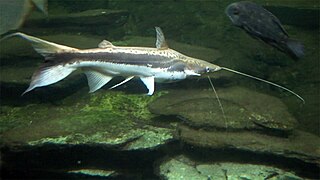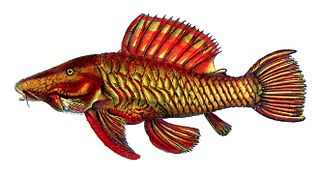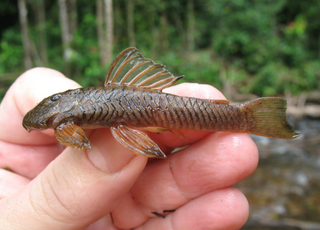
The Amblycipitidae are a family of catfishes, commonly known as torrent catfishes. It includes three genera, Amblyceps, Liobagrus, and Xiurenbagrus, and about 36 species.

Pseudoplatystoma is a genus of several South American catfish species of family Pimelodidae. The species are known by a number of different common names. They typically inhabit major rivers where they prefer the main channels and tend to stay at maximum depth, but some species can also be seen in lakes, flooded forests, and other freshwater habitats. They have robust bodies, and are important food fish. Recently, their population size has been on the drastic decline due to a variety of factors including overfishing and habitat destruction due to the construction of hydroelectric dams.

The Doradidae are a family of catfishes also known as thorny catfishes, raphael catfishes or talking catfishes. These fish are native to South America, primarily the Amazon basin and the Guianas.

The Cetopsidae are a small family of catfishes, commonly called the whale catfishes.

The stream catfishes comprise the family Akysidae of catfishes.

Sorubim is a small genus of long-whiskered catfish native to tropical South America. A number of characteristics allows the differentiation of each species in the genus. Sorubim species are important food fish in South America and are highly significant to fisheries of some areas; however, harvests of these fish are not identified as much as other, more popular food fishes such as Colossoma, Arapaima, and Brachyplatystoma. Some species of this family are popular aquarium fish.
Scoloplax is the only genus in the catfish family Scoloplacidae, the spiny dwarf catfishes.
Propimelodus is a genus of South American catfish of the family Pimelodidae.
Merodoras nheco is a species of freshwater ray-finned fish, it is the only species in the genus Merodoras of the catfish family Doradidae.

Parancistrus is a small genus of suckermouth armored catfishes native to South America.
Aguarunichthys is a genus of long-whiskered catfishes native to South America.
Breitensteinia is a genus of catfishes of the family Akysidae. It includes three species.

Cetopsis is a genus of catfishes of the family Cetopsidae.
Micromyzon akamai is a species of catfish in the family Aspredinidae.

Synodontis caudovittatus, known as the white-finned synodontis, is a species of upside-down catfish that is native to the Nile basin of Ethiopia, South Sudan, and Sudan. It was first described by British-Belgian zoologist George Albert Boulenger in 1901, from specimens collected in the White Nile, at the mouth of Lake No in South Sudan. The species name caudovittatus comes from the Latin word cauda, meaning "tail", and the Latin word vitta, meaning "stripe" and refers to the coloration of the tailfin.

Synodontis frontosus, known as the Sudan squeaker, is a species of upside-down catfish that is widely distributed throughout northern and central Africa. It has been reported in Chad, Democratic Republic of the Congo, Ethiopia, Kenya, Somalia, Sudan, and Uganda. It was first described by French zoologist Léon Vaillant in 1895, from specimens collected in the White Nile in Sudan. The species name frontosus is Latin, and means "broad head".

Guyanancistrus nassauensis is a species of catfish belonging to the family Loricariidae, the suckermouth armored catfishes. It is discovered in 2005 and formally described in 2018. G. nassauensis is a rare species, highly endemic to the Nassau Mountains in Suriname, and is threatened with extinction by proposed or ongoing mining activities.
Bryconops munduruku is a small freshwater fish of the family Iguanodectidae that lives in the rivers of South America. Its adipose fin is black, with a clear base, and it has two humeral spots, which is a feature it shares with few congeners. Its fins are a variety of yellow, red, black, and clear, and mature males have hooks on select fin-rays.
Bryconops rheoruber is a species of freshwater fish from the rivers of Brazil. Its back scales are tan-to-cream, and its belly is silvery; the divide between the two colors is marked by a broad iridescent-silver stripe. Its fins are a mixture of pale, clear, and reddish, which contributed to its specific name. "Rheo" means "flow" or "current" in Greek, and "ruber" means "red" in Latin.
Scoloplax dicra is a species of spiny dwarf catfish found throughout the river basins of South America.












